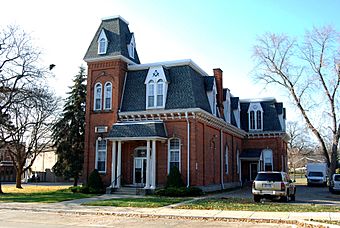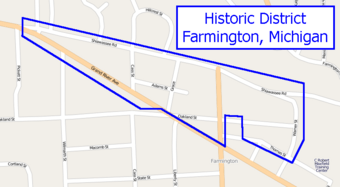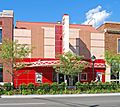Farmington Historic District (Farmington, Michigan) facts for kids
Quick facts for kids |
|
|
Farmington Historic District
|
|

The Masonic Lodge is near the center of this historic district and was previously used as the city hall
|
|

Boundaries of the district
|
|
| Location | Grand River Ave and Shiawassee Ave from Warner St to Jct, Farmington, Michigan |
|---|---|
| Area | 35 acres (14 ha) |
| Built | 1823 |
| Architect | Johnson S. Prall |
| Architectural style | Greek Revival, Late Victorian |
| NRHP reference No. | 76001034 |
| Added to NRHP | June 18, 1976 |
The Farmington Historic District is a special part of Farmington, Michigan, right in the heart of the town. It's like a time capsule, showing how the area used to look. This important district was added to the National Register of Historic Places in 1976. It covers parts of Grand River Avenue and Shiawassee Avenue.
Contents
How Farmington Started: Early History
In 1823, a man named Arthur Power bought a lot of land here. He was a Quaker from Farmington, New York. Arthur Power moved to Michigan in 1824 with his family. Many other Quaker families soon followed him.
By 1826, the village of Farmington was growing fast. It was located along the Shiawassee Trail. The settlement had at least three churches and a school. There were also two taverns and several shops. People also ran dairies and cheese factories. There was a small foundry and several mills for lumber and grain. Many homes were built in the "Old City" area. Some of these old homes are still standing today! By the mid-1840s, the town center moved to Grand River.
Farmington's Growth and Changes
The village grew quickly between 1850 and 1890. More new settlers arrived, and the Quaker influence slowly became less strong. Farming was the main way people made money back then.
In 1872, a big fire destroyed many businesses. But Farmington kept growing after 1890. New technology and better transportation helped the town. Even by 1950, only about 2,300 people lived there. However, by 1960, many people moved from Detroit to Farmington. The population jumped to over 7,000. By the mid-1970s, it reached 12,000 people!
What You'll See in the Historic District
The Farmington Historic District is shaped like a triangle. Most of the buildings are homes. The rest are businesses. Some buildings are very old, dating back to the 1840s. You can see many old farmhouses. There are also many modest buildings in the Greek Revival style. This style often features columns and simple, balanced designs.
Important Buildings to Explore
The district includes some very important buildings in Farmington:
- Governor Fred M. Warner House: This house was built in 1867. It's a block-shaped house with a low, flat roof. It has a small tower, called a cupola, on top.
- The Masonic Lodge: This building was finished in 1876. It used to be the Township Hall. It's a two-story building with towers and arched doorways. Its roof is made of patterned slate tiles.
- Farmington Civic Theatre: This is another notable building in the district.
Gallery







